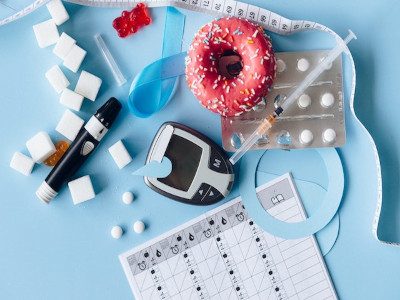Diabetes is a chronic disease that affects how the body uses blood sugar. Blood sugar is called glucose, and it is an important energy source for cells and our brain. Diabetes occurs when the pancreas doesn’t produce enough insulin or the body is unable to use the insulin. Insulin is a hormone that helps the body regulate glucose. If you suffer from hyperglycemia, it means your blood sugar is too high, which may indicate that you might have diabetes. The main cause of diabetes comes from type. There are three main types of diabetes: type 1, type 2, and gestational diabetes (which can occur while pregnant). The most common symptoms of diabetes are increased thirst, slow-healing cuts and sores, fatigue, blurred vision, frequent urination, and unexplained weight loss.
Type 1 diabetes (shortly called T1D) is an autoimmune disease. It means that your body is producing insulin, but your immune system destroys the insulin-producing cells. T1D is usually diagnosed at a very young age, but the age doesn’t matter because it can develop later as well. How can you notice that you may have T1D? The symptoms may appear quickly, within a few months. The symptoms usually include vomiting, stomach pains, fruity-smelling breath, and labored breathing.
Type 2 diabetes (shortly called T2D) means that your body doesn’t produce enough insulin or your body’s cells don’t respond normally to insulin; this is called insulin resistance. It can affect anyone, but mainly adults have it. With T2D, you might not have any symptoms because they develop slowly. One sign of T2D can be darkened skin on some parts of your body. Other than that, the best way to make sure you don’t have T2D is to have regular bloodwork.
Gestational diabetes will only occur during pregnancy, and it wouldn’t happen to all pregnant women. It usually goes away after the pregnancy ends. However, if you get it, you might also develop type 2 diabetes. For gestational diabetes, your healthcare provider will do regular check-ups between weeks 24 and 28 of pregnancy.
Why diabetes is called a defining disease in the 21st century. In 2019, there were more than 37,1 million people who had diabetes, which is 11.3% of the total population. This number only considers people who are older than 18. It is estimated that by 2050, more than 1.3 billion people may live with diabetes, which means that 1 in 10 people around the world will have it. The growth of diabetes will probably come from type 2 diabetes because it is caused by the growing prevalence of obesity and changes in demographics. In 2021, type 2 diabetes accounted for 90% of all diabetes cases. The majority of this burden can be attributed to social factors such as high body mass index, unhealthy diets, exposure to environmental and occupational risks, tobacco and alcohol use, and a lack of physical activity. These factors are influenced by the way our environments are designed to promote obesity, the unequal distribution of resources, and societal organization.
The longer you have diabetes, and if you are not controlling it, the more risk you are of getting complications. Diabetes complications may even be life-threatening, or they can disable you. The main complications that you might get when you have diabetes are: heart and blood vessel diseases, nerve damage, kidney damage, eye damage, foot damage, skin and mouth conditions, hearing impairment, Alzheimer’s disease, and depression related to diabetes.
In the conclusion, you will read about some ways to prevent type 2 diabetes, because type 1 diabetes you can’t prevent, but you can control it with injections of insulin. People with type 1 diabetes have to check their blood sugar level regularly. Type 2 diabetes is generally preventable if you choose a healthy lifestyle. You should eat healthy food, avoid extra sugar and saturated fats, be physically active, don’t smoke, and lose excess pounds. Some people may also need to take some medicine (an insulin injection or other medicine) to keep their blood sugar low. In general, you should have your blood checked every year.

Sources:
https://www.who.int/news-room/fact-sheets/detail/diabetes
https://www.mayoclinic.org/diseases-conditions/diabetes/symptoms-causes/syc-20371444
https://my.clevelandclinic.org/health/diseases/7104-diabetes
https://www.niddk.nih.gov/health-information/health-statistics/diabetes-statistics
https://www.thelancet.com/journals/lancet/article/PIIS0140-6736(23)01296-5/fulltext
